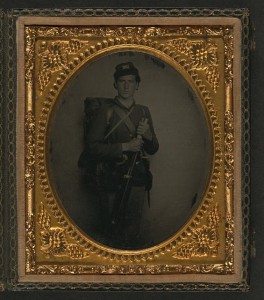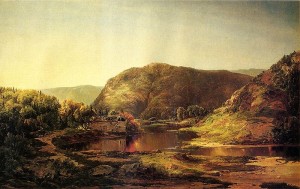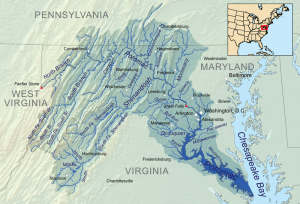What was the 19th New York Volunteer Infantry doing 150 years ago today?
The drums beat an early reveille next morning. Blankets were hurriedly rolled up. ” Sling knapsacks,” commanded the Colonel. A long march being in prospect, some of the men, rather than carry those weighty knapsacks another day, did sling them with a vengeance — over the fence. A few were fortunate enough to obtain permission, as a special favor, to have them carried in the wagons. As fifteen wagons only were allotted to the regiment, many permissions of this sort could not be granted.
The 28th New York took the advance as usual and marched on down through the village and crossed the river; the 19th New York followed. Between verdant and romantic banks, the Potomac flows here in a current half a mile wide — not over three feet deep. Adjutant Stone leaped into the stream first; the column followed manfully in after him, and strode through the gurgling water with the nonchalance of regulars. A few took off their shoes, that they might resume the march with dry feet. Others rolled up their baggy pants. All held up their cartridge boxes. Emerging from the Potomac, the 19th New York stood on the ” sacred soil ” of rebeldom and at the entrance to one of its fairest regions — the far-famed Shenandoah Valley. It was a lovely vale — broad, gently undulating, dotted with groves and farms, and yielding such prolific crops of grain and rich fruit, that it was called the granary of Virginia. On either side, ranges of blue mountains stretched away into the remote distance till lost in view in the gathering haze which perpetually overhangs this region, giving it magical beauty and making its mountain ranges of so soft and ethereal blue that they seem the creations of enchantment. The silvery Shenandoah wound through the valley, gleaming between dark groves.
On the bank of the Potomac a halt was ordered, and the dripping regiment improved the opportunity to wring its garments and eat breakfast. At noon Capts. Schenck and Stewart with their companies were left at the ford to wait for Kennedy and Doubleday’s gun, and the regiment went on towards Martinsburg. At Falling Waters, six miles on the way, the scene of the late brush between Patterson and the rebels, a pause was made. The havoc of war, present on all sides, was viewed with curious eyes. Fences were, for miles, down; trees shattered with cannon shot; crops trampled to the earth; farm houses were in ashes; here and there dead rebels dotted the fields; arms and equipments were scattered everywhere. One farm house had a cannon shot hole in it. A Federal flag fluttered from a stick projecting from the hole.
While waiting here, the volunteers picked up many mementoes of the fight to carry with them. A sabre and a revolver from a dead rebel, who lay with pallid, upturned face in the grass, were among them.
At 2 p, M. Schenck and Stewart were ordered up, and Lieut- Col. Seward was dispatched to Hagerstown to ascertain the cause of Kennedy’s delay. Col. Clark then put the regiment in motion again for Martinsburg, nine miles distant. Company A, the leading company, pushed rapidly ahead and caught up with the 28th regiment three miles ahead. The others followed briskly, marching a large part of the way on the double-quick, the men in good spirits and singing “John Brown’s body lies a mouldering in the grave,” “Star Spangled Banner,” and other patriotic choruses. As the day was hot and marching swift, the heavy equipments of the volunteers again oppressed them. They endured it as long as they could and then scores threw away knapsacks, others blankets, and some pairs of fine boots, anything for relief. It was a severe thing for green soldiers to march fifteen miles under a hot sun. The manner in which they endured its discomforts showed their excellent grit.
On this march, as in all others when not in presence of the enemy, the regiment moved in loose, open order, the men taking the sides and middle of the road as they chose, and carrying their arms at will. This is called taking the “route step.” It is only required that companies maintain their relative positions and distances. At the command “Attention,” the men run together and form in compact order, the drums beat giving them the cadence, and in less than a minute’s time the apparent chaos resolves itself into the beautiful, orderly, regular column of warfare. A regiment on the march is always a magnificent spectacle, and whether in open or compact order, impresses the beholder with its moral power. The field and staff, we might say here, always ride at the head of the column. Further in advance, is the Officer of the Day with a guard to close taverns and liquor stands. In rear are the wagons and provost guard to pick up stragglers.
The regiment entered Martinsburg at 11 p.m. Camp fires burnt in all directions. Passing through the village by Gen. Patterson’s order, the regiment marched out on a road easterly about a mile, and then climbed a steep bank and a stone wall, arriving in a field, on the extreme right flank of Patterson’s army. The men were excessively tired. As they jumped over the stone wall, some of them knocked off stones which rattled down amongst those behind. Some murmurs were uttered at this. At Kalorama, some disorderly spirits had once groaned at Col. Clark. The Colonel on this occasion is said to have made an uncharitable remark about their groaning at the stone wall, as having now something to groan for. After stacking arms, the men fell immediately to the ground and slept, such as could sleep. The excitement of the situation kept some awake. They were in the presence of an army of 20,000 rebels, commanded by a General of consummate ability. The picket guards of the Union army not far away, out in the fields, were firing all night, firing at nothing as it proved, but still stimulating the imaginations of the soldiers bivouacked around Martinsburg and making them think gravely of the possibilities of the morrow.
From Cayuga in the Field by Henry Hall and James Hall.
The Map of the Potomac watershed is licensed by Creative Commons.




Pingback: Jayhawking With the Convict Regiment | Blue Gray Review